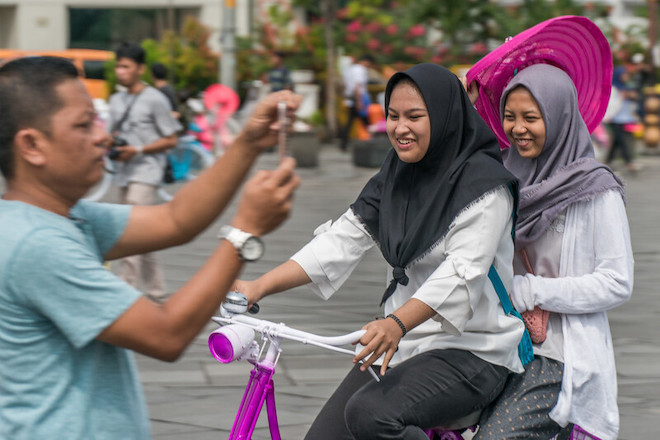
This article is published in collaboration with the Climateworks Centre.
The potential of waqf, a form of endowment under Islamic law, to finance the clean energy transition in Indonesia is vast. To make the most of this opportunity, Indonesia needs clear governance strategies.
With an estimated size of cash-based waqf donations at around $12 billion per year and cumulative land-based waqf assets at a staggering $134 billion, Indonesia can harness waqf resources as a local solution to local challenges as they relate to climate change and energy security.
A comprehensive governance strategy can help Indonesia leverage waqf’s potential in financing the country’s rather expensive energy transition.
Historically, it has been challenging to orient domestic waqf stakeholders toward climate initiatives, as illustrated in the Green Waqf Framework, published by the Indonesian Waqf Board (Badan Wakaf Indonesia, BWI).
We have outlined three steps Indonesia can take to align governments, faith-based institutions, and educational institutions with climate goals and the clean energy transition.
Step 1: Invest in building human capital
Public awareness of climate change is low within Indonesia, but public education could help turn the tide of understanding, especially around the benefits of transitioning to clean energy. Such an effort could also include waqf’s role in the climate discourse. Educational and capacity-building initiatives—supported by strong governance—could mobilize climate-focused waqf.
Key agencies such as BWI, the Ministry of Religion, the Ministry of Education, and the Ministry of Information and Communication can collaborate on education or professional certification for waqf management, including climate uses for waqf funds.
Education and capacity building can help mainstream waqf in Indonesia’s overarching strategy to reach net zero. For example, capacity building at the BWI could elucidate waqf’s role within the government’s existing climate funding programs, such as the Asian Development Bank's Energy Transition Mechanism (ETM) country platform. The ETM platform recently launched at the G20, mobilizes funding from various sources, including multilateral development agencies, climate finance institutions, and philanthropists for Indonesia’s energy transition.
Indonesia can also look to its Hajj Fund Management (Badan Pengelola Keuangan Haji, BPKH), a public service agency overseeing hajj (pilgrimage) funds. While BPKH’s fund has not specifically focused on reinvesting in climate initiatives, the agency has been successfully growing its hajj fund over time. BWI could manage waqf assets in a similar way to BPKH to finance the mid-to-long-term energy transition.
As for waqif, the people who make waqf donations, Indonesia could issue guidelines on how to designate their waqf donations for climate-positive outcomes.
Step 2: Establish strong coordination between government and non-government actors
In parallel with education efforts, strong governance and institutional reform are also necessary to mobilize waqf for the climate.
Effective governance will require coordination between various government agencies—BWI, the National Amil Zakat Agency, subnational governments, the Central Bureau of Statistics, the Ministry of Education, Culture, Research and Technology (Kementerian Pendidikan, Kebudayaan, Riset, dan Teknologi) etc.—and non-government stakeholders, including faith-based organizations and educational institutions.
At a high level, Indonesia does not yet have strong policy underpinnings for aligning waqf and climate targets. Hence, there is an opportunity to incorporate climate waqf in the national planning frameworks, such as the Long-Term National Development Planning and the Mid-Term National Development Planning, which would lead to the creation of technical regulations and incentives to use waqf assets to finance climate goals, including clean energy transition targets.
Step 3: Build a clear, technical blueprint for climate waqf
Upon aligning waqf and climate targets in the national development plans, Indonesia’s next step will be to create a technical blueprint for aligning waqf—largely sourced from private funds—with the public climate financing strategies, such as the much anticipated Climate Change Fiscal Framework (CCFF) to be issued by the Ministry of Finance. The blueprint could establish a clear legal framework and types of government support for waqf-based climate and energy transition projects. For instance, the blueprint could demonstrate how to securitize land-based assets under waqf for solar projects and how tax breaks and other fiscal incentives could further support these solar projects.
Alongside the blueprint, Indonesia can also outline steps to accelerate waqf certification processes, which would help establish the legal underpinning of waqf assets. Waqf certifications will involve the Indonesian National Land Agency, as land waqf is the primary form of waqf endowment.
A blueprint could be strengthened further with an added supervisory function to ensure the waqf objectives are met, funds are allocated toward climate actions, and appropriate accounting standards are followed.
Indonesia has a long journey to fully leverage waqf for its climate targets, but with careful and strategic steps, the future is bright. Ultimately, a localized and tailored approach should be prioritized, and Indonesia is well-positioned to tap into this opportunity.
 Brurce M. Mecca
Brurce M. Mecca
Senior Analyst, Climateworks Centre
Brurce Mecca spearheads analysis around mobilizing finance for climate in Indonesia with a focus on practical recommendations for governments and businesses to facilitate enabling environments and credible investment strategies supporting a net zero emissions future. Brurce is also working to build strategic partnerships with stakeholders in Southeast Asia and Asia Pacific on climate finance, blue finance, and carbon markets.
 Guntur Sutiyono
Guntur Sutiyono
Country Lead, Indonesia, Climateworks Centre
Guntur Sutiyono leads Climateworks’ Indonesian team, enhancing Climateworks’ understanding of the region by providing context around policy, politics, and the economic landscape. His team is responsible for assessing opportunities and acting as a trusted advisor to stakeholders, with Guntur overseeing projects in sustainable finance, fiscal policy, energy, and support business development. Prior to joining Climateworks, Guntur worked for the Climate Policy Initiative and the World Bank as an analyst covering topics including fiscal policy, public finance, climate finance, and environmental economics. Guntur has also worked with governments, local universities, and civil society organizations, providing analysis and capacity building.
 Petra Christi
Petra Christi
Senior Analyst, Climateworks Centre
Petra Christi works within the International and Country Context team, supporting data analysis and policy analysis, focusing on gaps and opportunities for sustainable finance in Indonesia. Petra started as a student intern at Climateworks, supporting the International team on the Indonesia Electricity Roadmap, working on regulatory analysis and energy sectoral planning and development. Since then she has contributed to the team’s work on Indonesia’s Green Economic Recovery, Indonesian financial system climate action mapping, Indonesia’s long-term strategy on low carbon and climate resilience, the ASEAN energy transition, and a natural disaster insurance framework for MSMEs in Indonesia.
This article was first published by the Climateworks Centre on 22 November 2022.

